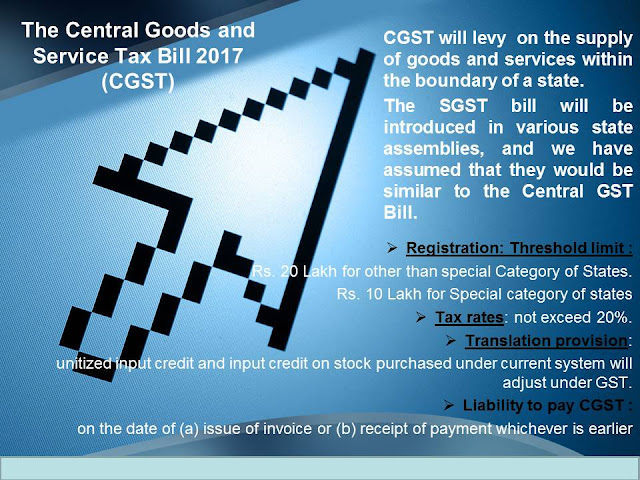Key highlights of the bill
Ø
The Central Goods and Services Tax Bill, 2017 was introduced in Lok
Sabha on March 27, 2017. The Bill
provides for the levy of the Central Goods and Services Tax (CGST).
Ø
Levy of CGST :
The CGST will levy on the supply of goods and services within
the boundary of a state. Supply include
sale, transfer and lease made for a consideration to further a business.
Ø
Tax rates :
The tax rates will be
recommended by GST Council. It will not exceed 20%. Further it allows flat rate
of GST on turnover, instead on the value of supply of goods and services (under
composition levy) to certain taxpayers whose turnover is less than Rs. 50 lakh.
Ø
Exemptions from CGST
:
Certain goods may exempt
from the purview of GST through notification based on the recommendation of GST
council.
Ø
Liability to pay
CGST :
Liability to pay CGST will
arise on the date of (a) issue of invoice or (b) receipt of payment whichever
is earlier in relation to supply of goods and services.
Ø
Value of supply for levy
of CGST (Taxable value):
Taxable value of goods and
service for levy of CGST will include :
(a)
Price paid on the supply
(b)
Taxes and duties levied under a different tax law
(c)
Interest, late fee, penalties for delayed payments.
Ø
Input Tax credit
under CGST :
Every taxpayer while paying
taxes on outputs, may take credit equivalent to taxes paid on inputs. However, this will not be applicable on
supplies related to:
(a) personal consumption,
(b) supply of food, outdoor catering, health
services, etc. unless they are further used to make a supply.
Ø
Registration :
Threshold limit for mandatory
registration under GST :
Rs. 20 Lakh for other than
special Category of States.
Rs. 10 Lakh for Special
category of states*
* Arunachal Pradesh, Assam,
Jammu and Kashmir, Manipur, Meghalaya, Mizoram, Nagaland, Sikkim, Tripura, Himachal
Pradesh and Uttarakhand.
Ø
Returns :
Every taxpayer will require
to file return on monthly basis. In addition to monthly return taxpayer will
also require to file annual return.
Ø
Transition to the
new regime:
Taxpayers with unutilised
input tax credit obtained under the current laws such as CENVAT may utilise it
under GST. In addition, businesses may
also avail input tax credit on stock purchased before the start of
implementation of GST.
Ø
Anti-profiteering
measure:
The central government may
by law set up an authority or designate an existing authority to examine if
reduction in tax rate has resulted in commensurate reduction in prices of goods
and services. The powers of the
authority will be prescribed by the government.
Ø
Compliance rating
Every taxpayer shall be
assigned a GST compliance rating score based on his record of compliance with
the provisions of this Bill. The
compliance rating score will be updated at periodic intervals and be placed in
the public domain.


No comments:
Post a Comment